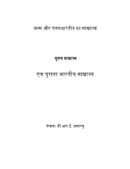You can access the distribution details by navigating to My Print Books(POD) > Distribution
Description
India & America: Then and Now
In my third year at college in India, a rock band came to town. They held a concert in the center of the campus, at what were called the D-Lawns. I was painfully shy in college, and had just about one friend. I was a complete loner; everyone shunned me. I made my way to the concert alone and saw an empty piece of grass, looked at the guy behind me and asked him for permission to sit down when I had no need to, and then plonked myself down, embarrassed at all the fuss I had created.
It was 1988. Since I was a loner, I was always philosophizing to myself. Why did India ape all of the evil of the West? Why didn't it imbibe some of the energy? These questions plagued me. Of course, I did not share my thoughts with anyone. An episode of bipolar depression the year before had dropped me from the perch of the straight topper in a batch of 700 students. No one in my college or at home or the doctors my dad showed me to knew what bipolar was. People in college just assumed that I had gone mad. My father started reading up on depression; I hated him for it.
My father was born in 1931, a full 16 years before India gained independence from the British in 1947. My father belonged to a Delhi family of lineage; still he attended Sanskrit school. Over time he improved his English to the finest I have ever read. His formative years were spent in the Raj. Soon after college, he joined the Indian army in a world-famous cavalry regiment formerly known as the Royal Second Lancer's, now only as the Second Lancer's. The regiment strictly maintained its British customs; each new officer recruit had to do a head stand and while doing so, drink whiskey from a goblet on the floor. If you passed this initiation ceremony, you were accepted into the regiment; otherwise you kept trying until kingdom come.
My father became what came to be known as the archetypal brown sahib: brown Indian masters that the British had left behind. My father was very Indian but could speak with an Anglicized accent, referred to Indians as kaalus (blackies), and did not allow any journal or book written in his mother tongue, Hindi, at home. He didn't like the British for what they had done to India or how they had treated Indians, but still lived like them. An ace shot, he was a master Western dancer, drank like a fish, and smoked like a chimney.
My father was not very different from others of his ilk. 1993 saw my older brother getting married. A wedding reception was held in the lawns of the army club in Delhi. Assembled were my father's colleagues, many retired colonels and generals. My cousin, who was a civilian and a businessman, remarked: Oh, they should all go to good ole Blighty. Blighty of course meant England. It was a derivative of the Hindi word, bilayati, meaning foreign. All of us civilians present cracked up laughing.
I was born in late 1968. My father made sure that I did not partake of traditional Indian sports like kabbadi, kite-flying, and gulli-danda (stick on stick). Lord Macaulay of England had tried in the first half of the nineteenth century to take out the Indian from every Indian; my father in my case was just as determined as Macaulay. I could play only western sports like cricket, soccer, field hockey, track or karate. My father taught me French. One of my earliest memories is of opening a British encyclopedia with a color picture of the Queen Elizabeth II. She looked beautiful. I remarked so. Since then I have always associated female beauty with pale skin; even though I now realize that the queen wasn't all that beautiful.
From the same encyclopedia, my mother read me Tennyson's Charge of the Light Brigade. We were a cavalry family after all; we had but to do or die. India under Nehru was practicing Fabian socialism. Nehru didn't like the US, although rumors abounded of an affair between him and Jackie Kennedy or her sister Lee Radziwill or both when they visited him when he was the prime minister of India in the early sixties and JFK was in the White House. Certainly Radziwill is known to have remarked that she found him terribly handsome, Adonis that he was, even though almost twice the women’s age.
My earliest memories of Americana was a record of Saturday Night Fever, and Gola shoes, American-style sneakers. And then dad got us pairs of Levi's jeans, which made us the envy of the whole neighborhood. In the early eighties, my father went to work in Baghdad. He got us a double-deck cassette player with which I recorded every western album known to man. I was in high school in Delhi. All pretty unremarkable except that I was not so shunned there as I would find myself later at college, the Birla Institute of Technology & Science, Pilani, a school co-founded by MIT.
Here I was to experience Americana in all its bloom. Marijuana was a staple diet. A former Indian prime minister had died. The federal government declared a holiday, but the institute stayed open. Asked why, the director remarked, we are not an Indian institute; we are an American institute that finds ourselves in India.
In 1984, my brother went to the US to study. Those days, highly prized and much sought-after gifts in India were Hershey and Toblerone chocolates. If you returned empty-handed from the US, no one would talk to you. More and more Indian students started going to the US and returning to India wearing Levi's jeans and Tommy Hilfiger shirts. A craze for these brands developed in India.
1991 saw India going bankrupt. The IMF installed its chosen man, Manmohan Singh, as the country's finance minister and told him to do as told. In retrospect, he ran even faster than told and opened the Indian economy with a ferocity alien to the Indian psyche. India then had a middle and rich class with the purchasing parity of its American counterpart of about 50 million (today it is about 300 million). The IMF (or the Americans) wanted to satisfy this class hungry for foreign goods.
Beloved Indian brands like the Kissan tomato sauce were trashed; Heinz came in. Coke and Pepsi for Thums Up. Lay's for all other potato chips. Kellogg's for Indian corn flakes (as cereal is called in India). 1991 also saw the advent of satellite TV in India. Oprah was in every living room. So was Dr. Phil. MTV showcased Michael Jackson and Madonna. Fashion shows saw women revealing more than half their breasts. People saw TV and thought this was exactly how Americans lived, that they worked hard and played harder.
Indians forgot the work hard bit, but started playing harder. The magazine India Today ran a cover story about teenage sex in India. It said that kids were indulging in multiple sexual partners. Hey, but wasn't that the case in America? If it was right for Americans, it must be doubly right for us. Out on a bride scouting trip to India in 2001, I met an Indian girl. She said just don't think of looking for virgins here; they are practically extinct. She said that every 14-year old has a boyfriend, and they are not just holding hands. A sexual revolution had swept over India: live-ins, pre-marital sex, children out of wedlock, extra-marital sex, open marriages. I mean, weren't we the land of the Kamasutra. But we were getting our sexual mores from the Americans, not the ancient text, which actually was teaching Americans some.
Today, some Indians might deny the impact of America, but India has come full circle from the British times of my dad, to the half-British half-American of my time, to the completely American times of today. The book discusses the various ways in which America has already impacted India, to ways such as multi-brand retail and all kinds of insurance that are sure to affect India greatly in the future. It does not fail to address areas where India and America have seemingly felt betrayed by each other. India for instance covets a permanent seat in the UN security council, but the US doesn't get it for India. America would like to sell more arms to India especially fighter aircraft, but India has been stubborn in diversifying its arms sources.
Also, the book discusses how real the contain-China policy of the two nations is. The Chinese are far ahead of the Indians in the capabilities of their navy and air force. The US has signed a pact with Japan and South Korea to protect them from China/Korea and Japan respectively, but as its engagement with Kim Jong-un of North Korea shows, the US may not show up for its date with its Asian allies in their times of need. People in East Asia and India are convinced that the US will only move to protect a white Anglo-Saxon protestant ally like the UK, that when rubber meets the road, the US will leave them in the lurch.
A confrontation between the US and China seems possible in the first half of this century. India of course cannot take the side of old enemy China. But will it take the side of the US? Or will it continue to kow tow to China as it is doing right now and watch from the sidelines? What's the point then of blaring that the US and India are natural allies, strategic allies, natural and strategic allies, and what not.
About the Author
Book Details
Ratings & Reviews

Currently there are no reviews available for this book.
Be the first one to write a review for the book How America's Transformed India.
Other Books in Social Science, History
डी.आर.ई. ज़मा न्यु
Dinachandra Chingakham & Biren Khwairakpam
பிரான்ஸிஸ் கிங்ஸ்பரி
Ecological Society

 Free Shipping
Free Shipping



